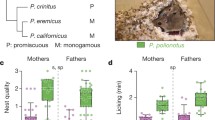Abstract
Infanticide is a reproductive strategy found in many mammals, especially rodents. The proportion of male and female house mice (Mus domesticus) that are either infanticidal or noninfanticidal is strain specific and varies widely from stock to stock. Male house mice also show strain-specific variation in the behavioral mechanisms that inhibit infanticidal individuals from killing their own offspring. The adult offspring generated from reciprocally crossed CF-1 and Wild stock house mice were tested for their behavior toward newborn pups. In male CF-1xWild hybrids, the proportion of infanticidal and noninfanticidal males matched with their maternal phenotype, whereas female CF-1xWild hybrids exhibited a proportion of behaviors typical of the CF-1 phenotype, regardless of their mother's genotype. Our results suggest three conclusions: first, that infanticide is a highly labile and heritable behavior in both sexes; second, that there is a sex difference in the genetic substrate that regulates the inheritance of infanticidal behavior; and third, that selection pressures in male mice may operate independently on the mechanisms that promote spontaneous infanticidal behavior versus the mechanisms that inhibit infanticide.
Similar content being viewed by others
References
Berry, R. J. (1981). Town mouse, country mouse: Adaptation and adaptability in Mus domesticus (M. musculus domesticus).Mammal Rev. 11:91–136.
Bronson, F. H. (1979). The reproductive ecology of the house mouse.Q. Rev. Biol. 54:265–299.
Elwood, R., Masterson D., and O'Neill, C. (1990). Protecting pups in tests for infanticidal responsiveness in mice,Mus domesticus.Anim. Behav. 40:778–780.
Hausfater, G. and Hrdy, S. (eds.) (1984).Infanticide: Comparative and Evolutionary Perspectives, Aldine, Chicago.
Hrdy, S. B. (1979). Infanticide among animals: A review, classification, and examination of the implications for the reproductive strategies of females.Ethol. Sociobiol. 1:13–40.
Huck, U., Soltis, R., and Coopersmith, C. (1982). Infanticide in male laboratory mice: effects of social status, prior sexual experience, and basis for social discrimination between related and unrelated young.Anim. Behav. 30:1158–116.
Kennedy, H., and Elwood, R. (1988). Strain differences in the inhibition of infanticide in male mice (Mus musculus).Behav. Neur. Biol. 50:349–353.
Mann, M., Kinsley, C., Broida, J., and Svare, B. (1983). Infanticide exhibited by female mice: Genetic, developmental and hormonal influences.Physiol. Behav. 30:697–702.
Marshal, J., and Sage, R. (1981). Taxonomy of the house mouse.Symp. Zool. Soc. Lond. 47:15–25.
McCarthy, M., and vom Saal, F. S. (1985). The influence of reproductive state on infanticide by wild female house mice (Mus musculus).Physiol. Behav. 35:843–849.
Mennella, J., and Moltz, H. (1988). Infanticide in rats: Male strategy and female counter-strategy.Physiol. Behav. 42:19–31.
Palanza, P., and Parmigiani, S. (1991). Inhibition of infanticide in Swiss male mice: Behavioral polymorphism in response to multiple mediating factors.Physiol. Behav. 49:797–802.
Perrigo, G. (1990). Food, sex, time and effort in a small mammal: Energy allocation strategies for survival and reproduction.Behaviour 114:191–205.
Perrigo, G., and Belvin, L. (1992). Time and sex in the male mouse: Temporal regulation of infanticide and parental behavior.Chronobiol. Int. 9:421–433.
Perrigo, G., and Bronson, F. H. (1982). Signaling and priming communication: Independent roles in the reproductive isolation of spatially-separated populations of rodents.Behav. Ecol. Sociobiol. 10:181–184.
Perrigo, G., and vom Saal, F.S. (1989). Mating-induced regulation of infanticide in male mice: Fetal programming of a unique stimulus-response. In Blanchard, R., Brain, P., Blanchard, D., and Parmigiani, S. (eds.),Ethoexperimental Approaches to the Study of Behaviour. Kluwer, Dordrecht, The Netherlands. pp. 320–336.
Perrigo, G., Belvin, L., Bryant, W. C., and vom Saal, F. S. (1989a). The use of live pups in a humane, injury-free test for infanticidal behavior in male mice.Anim. Behav. 38:897–898.
Perrigo, G., Bryant, W. C., and vom Saal, F. S. (1989b). Fetal, hormonal and experiential factors influencing the mating-induced regulation of intanticide in male house mice.Physiol. Behav. 46:121–128.
Perrigo, G., Bryant, W. C., and vom Saal, F. S. (1990). A unique neural timing mechanism prevents male mice from harming their own offspring.Anim. Behav. 39:535–539.
Perrigo, G., Belvin, L., and vom Saal, F. S. (1991). Individual variation in the neural timing of infanticide and parental behavior in male house mice.Physiol. Behav. 50:287–296.
Soroker, V., and Terkel, J. (1988). Changes in incidence of infanticidal and parental responses during the reproductive cycle in male and female wild miceMus musculus.Anim. Behav. 36:1275–1281.
Svare, B., and Broida, J. (1982). Genotypic influences on infanticide in mice: Environmental, situational and experiential determinants.Physiol. Behav. 28:171–175.
Svare, B., and Mann, M. (1981). Infanticide: Genetic, developmental and hormonal influences in mice.Physiol. Behav. 27:921–927.
Svare, B., Kinsley, C., Mann, M., and Broida, J. (1984). Infanticide: Accounting for genetic variation.Physiol. Behav. 33:137–152.
vom Saal, F. S. (1983). Variation in infanticide and parental behavior in male mice due to prior intrauterine proximity to female fetuses: Elimination by prenatal stress.Physiol. Behav. 30:675–671.
vom Saal, F. S. (1984). The intrauterine position phenomenon: Effects on physiology, aggressive behavior and population dynamics in house mice. In Flannelly, K., Blanchard, R., and Blanchard, D. (eds.),Biological Perspectives on Aggression. A. R. Liss, New York, pp. 135–179.
vom Saal, F. S. (1985). Time-contingent change in infanticide and parental behavior induced by ejaculation in male mice.Physiol. Behav. 34:7–15.
Author information
Authors and Affiliations
Rights and permissions
About this article
Cite this article
Perrigo, G., Belvin, L., Quindry, P. et al. Genetic mediation of infanticide and parental behavior in male and female domestic and wild stock house mice. Behav Genet 23, 525–531 (1993). https://doi.org/10.1007/BF01068143
Received:
Accepted:
Issue Date:
DOI: https://doi.org/10.1007/BF01068143




